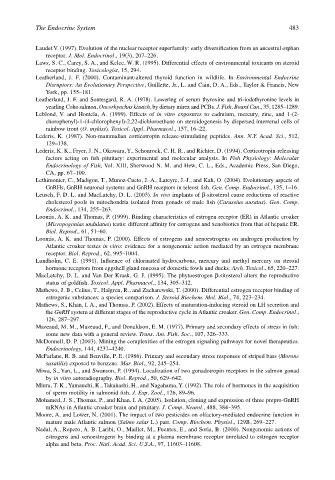Page 503 - The Toxicology of Fishes
P. 503
The Endocrine System 483
Laudet V. (1997). Evolution of the nuclear receptor superfamily: early diversification from an ancestral orphan
receptor. J. Mol. Endocrinol., 19(3), 207–226.
Laws, S. C., Carey, S. A., and Kelce, W. R. (1995). Differential effects of environmental toxicants on steroid
receptor binding. Toxicologist, 15, 294.
Leatherland, J. F. (2000). Contaminant-altered thyroid function in wildlife. In Environmental Endocrine
Disruptors: An Evolutionary Perspective, Guillette, Jr., L. and Cain, D. A., Eds., Taylor & Francis, New
York, pp. 155–181.
Leatherland, J. F. and Sontesgard, R. A. (1978). Lowering of serum thyroxine and tri-iodothyronine levels in
yearling Coho salmon, Oncorhynchus kisutch, by dietary mirex and PCBs. J. Fish. Board Can., 35, 1285–1289.
Leblond, V. and Hontela, A. (1999). Effects of in vitro exposures to cadmium, mercury, zinc, and 1-(2-
chorophenyl)-1-(4-chlorophenyl)-2,22-dichloroethane on steroidogenesis by dispersed interrenal cells of
rainbow trout (O. mykiss). Toxicol. Appl. Pharmacol., 157, 16–22.
Lederis, K. (1987). Non-mammalian corticotropin release-stimulating peptides. Ann. N.Y. Acad. Sci., 512,
129–138.
Lederis, K. K., Fryer, J. N., Okawara, Y., Schonrock, C. H. R., and Richter, D. (1994). Corticotropin-releasing
factors acting on fish pituitary: experimental and molecular analysis. In Fish Physiology: Molecular
Endocrinology of Fish, Vol. XIII, Sherwood N. M. and Hew, C. L., Eds., Academic Press, San Diego,
CA, pp. 67–100.
Lethimonier, C., Madigou, T., Munoz-Cueto, J.-A., Lareyre, J.-J., and Kah, O. (2004). Evolutionary aspects of
GnRHs, GnRH neuronal systems and GnRH receptors in teleost fish. Gen. Comp. Endocrinol., 135, 1–16.
Leusch, F. D. L. and MacLatchy, D. L. (2003). In vivo implants of β-sitosterol cause reductions of reactive
cholesterol pools in mitochondria isolated from gonads of male fish (Carassius auratus). Gen. Comp.
Endocrinol., 134, 255–263.
Loomis, A. K. and Thomas, P. (1999). Binding characteristics of estrogen receptor (ER) in Atlantic croaker
(Micropogonias undulatus) testis: different affinity for estrogens and xenobiotics from that of hepatic ER.
Biol. Reprod., 61, 51–60.
Loomis, A. K. and Thomas, P. (2000). Effects of estrogens and xenoestrogens on androgen production by
Atlantic croaker testes in vitro: evidence for a nongenomic action mediated by an estrogen membrane
receptor. Biol. Reprod., 62, 995–1004.
Lundholm, C. E. (1991). Influence of chlorinated hydrocarbons, mercury and methyl mercury on steroid
hormone receptors from eggshell gland mucosa of domestic fowls and ducks. Arch. Toxicol., 65, 220–227.
MacLatchy, D. L. and Van Der Kraak, G. J. (1995). The phytoestrogen β-sitosterol alters the reproductive
status of goldfish. Toxicol. Appl. Pharmacol., 134, 305–312.
Mathews, J. B., Celius, T., Halgren, R., and Zacharewski, T. (2000). Differential estrogen receptor binding of
estrogenic substances: a species comparison. J. Steroid Biochem. Mol. Biol., 74, 223–234.
Mathews, S., Khan, I. A., and Thomas, P. (2002). Effects of maturation-inducing steroid on LH secretion and
the GnRH system at different stages of the reproductive cycle in Atlantic croaker. Gen. Comp. Endocrinol.,
126, 287–297.
Mazeaud, M. M., Mazeaud, F., and Donaldson, E. M. (1977). Primary and secondary effects of stress in fish:
some new data with a general review. Trans. Am. Fish. Soc., 107, 326–333.
McDonnell, D. P. (2003). Mining the complexities of the estrogen signaling pathways for novel therapeutics.
Endocrinology, 144, 4237–4240.
McFarlane, R. B. and Benville, P. E. (1986). Primary and secondary stress responses of striped bass (Morone
saxatilis) exposed to benzene. Mar. Biol., 92, 245–254.
Miwa, S., Yan, L., and Swanson, P. (1994). Localization of two gonadotropin receptors in the salmon gonad
by in vitro autoradiography. Biol. Reprod., 50, 629–642.
Miura, T. K., Yamauchi, K., Takahashi, H., and Nagahama, Y. (1992). The role of hormones in the acquisition
of sperm motility in salmonid fish. J. Exp. Zool., 126, 89–96.
Mohamed, J. S., Thomas, P., and Khan, I. A. (2005). Isolation, cloning and expression of three prepro-GnRH
mRNAs in Atlantic croaker brain and pituitary. J. Comp. Neurol., 488, 384–395.
Moore, A. and Lower, N. (2001). The impact of two pesticides on olfactory-mediated endocrine function in
mature male Atlantic salmon (Salmo salar L.) parr. Comp. Biochem. Physiol., 129B, 269–227.
Nadal, A., Ropero, A. B. Laribi, O., Maillet, M., Fuentes, E., and Soria, B. (2000). Nongenomic actions of
estrogens and xenoestrogens by binding at a plasma membrane receptor unrelated to estrogen receptor
alpha and beta. Proc. Natl. Acad. Sci. U.S.A., 97, 11603–11608.

